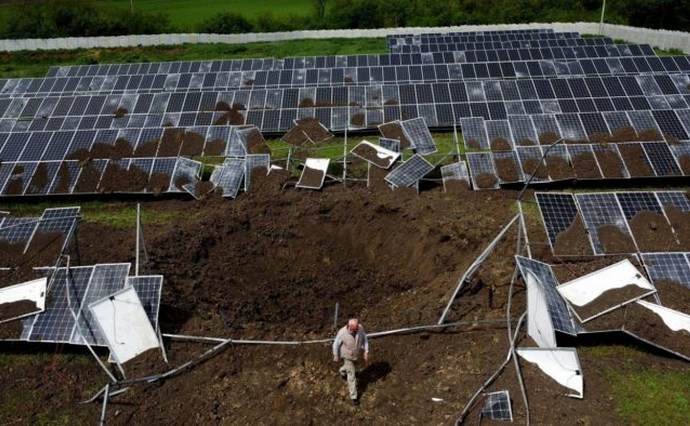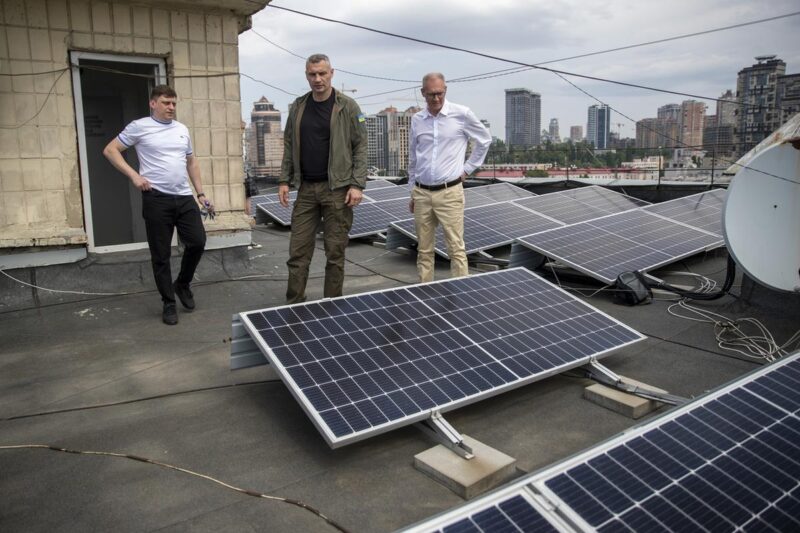€50 billion sits waiting. But Ukraine’s solar revolution measures just 102 MW. And Rome just promised more money through the same broken system.
The Ukraine Recovery Conference wrapped up in Rome last week with familiar promises: €2.3 billion in new agreements, including €265 million for “energy security and green transition” and €500 million in guarantees and grants to help Ukraine’s small businesses.
But missing from the announcements was any mention of fixing the fundamental problems that keep Ukrainian communities locked out of the European Union’s flagship funding tool, the Ukraine Facility.
€50 billion Ukraine Facility shows limited renewable energy results
Let’s be clear: this facility, worth €50 billion, is a significant commitment. Pillar II, the part meant to help rebuild Ukraine’s economy and support clean energy projects, has the potential to do real good. But right now, it’s still lagging behind. There is no data, transparency, or investor confidence. Most importantly, there is no access for small and medium-sized businesses.
The money is there. But the results are harder to find. One result was a bank survey conducted by the National Bank of Ukraine (NBU) with 20 banks, which showed that Ukrainian banks have issued 3,500 loans worth almost UAH 17 billion for energy projects.
It seems like a lot, however, many of the energy projects supported so far rely on diesel or gas, hardly the clean energy transformation we’ve been promised. The numbers tell the story: while solar projects received funding for 102 MW, gas-piston cogeneration units got 185 MW and diesel generators another 102 MW. Ukrainian banks financed nearly three times more fossil fuel capacity than solar power.
The scale of this shortfall becomes clear when you consider what Ukraine had before the war: approximately 9.9 GW of installed renewable energy capacity, including about 6 GW from solar power alone. Ukraine’s National Renewable Energy Action Plan aims for renewables to constitute 27% of electricity consumption by 2030, requiring a total installed capacity of 12.2 GW of solar energy.
That makes the current 102 MW addition look like what it is: a drop in the bucket.
Despite the ongoing war, Ukraine commissioned around 660 MW of new renewable energy capacities during 2022-2023, encompassing solar, wind, biogas, and small hydroelectric power plants.
Wind and solar power plants generated about 10% of Ukraine’s electricity as of 2023, with the share of clean energy produced, including large hydropower plants, reaching 20.3%—an increase from the pre-war period.
In 2024, Ukrainian state banks approved loans for the construction of 83 MW of solar power plants on the roofs of private households, which is an absolute record for the country since the implementation of such projects.
It should be noted that before the full-scale invasion, only 0.98 GW of grid-connected solar power plants had been built in Ukrainian households.
Ukraine energy funding lacks basic transparency
Citizens can’t even find a basic map showing where these 3,500 projects are located. No one knows exactly which projects have been funded, which regions are benefiting, or even how many of these projects have actually started working.
Some project details emerge piecemeal – like Mykolaiv’s 20 MW solar plants – but comprehensive data remains elusive. Citizens still can’t answer basic questions: Which oblasts received the most funding? How many small businesses applied versus how many got approved? What percentage went to Ukrainian companies versus international contractors?
These questions remain unanswered even after Rome. More basic transparency is needed, so that citizens and civil society can track where this money goes and whether it’s doing any good.
The small amount of information available in the public domain highlights that financial support for initiatives under Pillar II only started in 2025 and lacks a clear implementation schedule, despite the fact that these steps are crucial to improving Ukraine’s energy infrastructure and sustainable development in the face of current challenges.
As of today, all renewable energy projects implemented in Ukraine since 2022 are supported by leading international partners, rather than under Pillar II.
Even EU-supported analysis confirms the system’s dysfunction. A recent report by climate campaign group Razom We Stand found that there is “no comprehensive, publicly accessible database or consolidated statistical reporting” on funded projects. The report calls for establishing “a robust, transparent reporting system” – acknowledging the very transparency problems Ukrainian communities have been experiencing.

Small Ukrainian businesses shut out of EU energy funding
Then there’s the issue of who’s actually able to access these funds. Most of the financing so far seems to flow through international banks. But Ukraine’s recovery won’t come from top-down aid alone. Local businesses, especially small and medium-sized ones, are the backbone of any real rebuild. And right now, they’re shut out.
It’s not for lack of interest. Ukrainian companies and communities are eager to get involved in rebuilding through clean energy and sustainable infrastructure. But the application process under Pillar II creates barriers that seem designed to exclude them.
- Start with the money: many grant windows under Pillar II require €1 million minimum funding, which automatically excludes smaller regional providers or community energy initiatives. Then add excessive documentation requirements—multi-part technical, financial, and environmental submissions that mirror EU-level procurement formats.
- Most materials are available only in English or bureaucratic EU-style Ukrainian, with no clear summaries for local implementers.
- There’s little structured guidance to help applicants navigate these technical procurement rules. Local governments and SMEs are left to figure out highly complex eligibility criteria on their own.
- The scoring and selection criteria remain opaque, discouraging applicants who can’t afford dedicated bid writers or consultants.
The result? A system that talks about supporting Ukrainian recovery while systematically excluding Ukrainian actors from participating in their own rebuild.
Three months after Rome, the EU announced another €1.6 billion initiative for Ukrainian SMEs, scheduled for implementation in “the second half of 2025.” The pattern continues: more announcements, delayed implementation, while Ukrainian companies wait for access.
Despite all this, and against the backdrop of this devastating war, Ukraine is pushing forward with its clean energy revolution. Andriy Konechenkov, Chairman of the Board of the Ukrainian Wind Energy Association, recently announced that seven new wind power plants are currently under construction in Ukraine, with a total capacity of 4 GW of projects ready for implementation.
Last month, international consulting company Boston Consulting Group predicted an increase in the share of renewable sources in the structure of Ukrainian electricity production from 15% (2022 figure) to 28% until 2040, with the potential for further growth.
Balint Silhavi, Principal of the Boston Consulting Group, said: “We expect that about 50% of new generation will be solar and wind power plants. This means that the entire energy sector will become greener and greener.”

Rome chose more billions over basic fixes
These renewable energy projects and optimistic predictions show that Ukraine is working independently to push for renewable energy rebuilding. Rome was the moment to address the systemic dysfunction keeping Ukrainian communities locked out of their own recovery funding.
Instead, the EU chose to announce more billions flowing through the same broken channels.
Ukraine needs more than big promises. We need smart, targeted support that strengthens our economy, protects our communities, and builds toward long-term energy independence through renewables. Pillar II was meant to help deliver that. Rome should have fixed the system instead of feeding it more money.
This isn’t Ukraine’s first attempt at energy transformation that foundered on bureaucratic dysfunction.
In the late 2000s, Ukraine launched regional energy service companies like UkrESCO, which proved highly successful at implementing energy efficiency and investment projects. But the state failed to support their full privatization, retaining partial ownership through state enterprise shares.
The initiative lost momentum and never scaled—despite clear demand and early success.
That example shows what happens when system-level support disappears: even strong models fail to grow. Ukraine cannot afford to repeat that mistake with Pillar II, especially not while fighting for its survival.
Rome was the chance to course-correct. Instead, the EU chose to pour more billions into a system that systematically excludes the Ukrainian actors who should be rebuilding their own country.
As EU-funded research acknowledges, “continued collaboration with the Ukraine Facility and the European Commission is essential to prioritise renewable energy sources (RES) projects.” The question is whether this collaboration will finally deliver results or produce another year of billion-euro announcements while Ukrainian communities build their energy future independently.
Editor’s note. The opinions expressed in our Opinion section belong to their authors. Euromaidan Press’ editorial team may or may not share them.
Submit an opinion to Euromaidan Press




